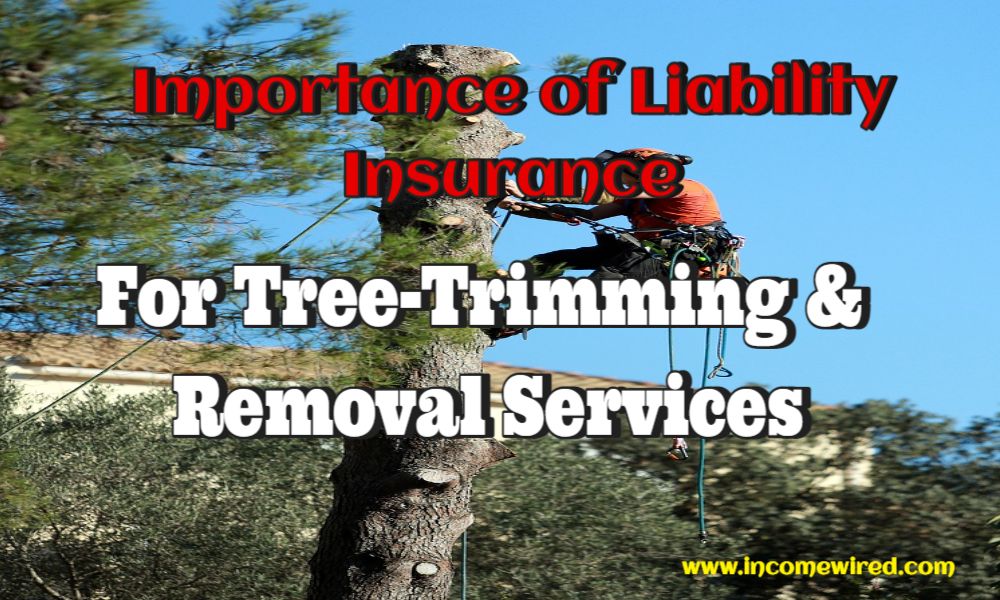we help service-based business owners, freelancers, and aspiring businesses with our content & services & When readers purchase services discussed on our site, we often earn affiliate commissions that support our work. Find out more about Income Wired
As a business owner in the tree trimming industry, insurance is a crucial component that should not be overlooked. Not only does it protect you against financial losses, but it also provides peace of mind and can help you build trust with your clients. However, with so many different types of insurance available, it can be difficult to know where to start. This article will provide you with a comprehensive guide on how to choose the right insurance coverage for your tree-trimming business.
- Assess your risks: The first step in choosing the right insurance coverage is to assess the risks associated with your business. To do this, you must consider various factors, including the type of work you perform, the areas you serve, the size of your business, and the level of risk associated with your work. For example, if you perform large-scale tree removal projects, you will likely face higher levels of risk compared to a business that only performs routine tree trimming. By fully understanding the risks you face, you will be better equipped to make informed decisions about the type and amount of insurance coverage you need.
- Review your contract requirements: Before you choose insurance coverage, it is essential to review any contractual requirements you may have. Some contracts may require you to have specific types of insurance, such as workers’ compensation or liability insurance, in order to perform work for a particular client. By understanding these requirements, you can ensure that you have the coverage you need to meet your contractual obligations and avoid any legal issues.
- Research insurance options: Once you have assessed your risks and reviewed your contract requirements, it is time to research the different insurance options available to you. Some common types of insurance for tree trimming businesses include general liability insurance, workers’ compensation insurance, and property damage liability insurance. Additionally, you may also consider purchasing additional coverage, such as product liability insurance or umbrella insurance, depending on your specific needs and risks.
- Consider the financial strength of the insurance company: When choosing insurance coverage, it is important to consider the financial strength of the insurance company you are working with. The financial strength of an insurance company can greatly impact its ability to pay claims, so it is essential to choose an insurance company that is financially stable and has a strong reputation in the industry. A good way to determine the financial strength of an insurance company is to check its financial ratings from independent agencies such as A.M. Best, Moody’s, and Standard & Poors.
- Review policy details and coverage limits: Before you choose insurance coverage, it is imperative to review the policy details and coverage limits offered by each insurance company. This includes understanding what is covered under each policy, as well as the deductibles and limits of coverage. For example, if you perform tree removal projects that involve the use of heavy machinery, you may need to choose a policy with higher coverage limits to fully protect your business. By thoroughly reviewing the policy details, you can ensure that you have the coverage you need to protect your business.
- Get multiple quotes: To ensure that you are getting the best coverage at the most affordable price, it is recommended that you get multiple quotes from different insurance companies. By comparing quotes, you can evaluate the different coverage options and choose the policy that best fits your needs and budget.
- Consider customer service and support: When choosing insurance coverage, it is important to consider the level of customer service and support offered by the insurance company. In the event of an accident or incident, you may need to file a claim, so it is essential to choose an insurance company that has a reputation for providing excellent customer service and support. You may also want to consider the responsiveness of the insurance company, as well as its reputation for paying claims promptly and fairly.
In conclusion, choosing the right insurance coverage for your tree-trimming business is an important decision that should not be taken lightly. By assessing your risks, researching insurance options, considering the financial strength of the insurance company, reviewing policy details, getting multiple quotes, and considering customer service and support, you can ensure that you have the coverage you need to protect your business and provide peace of mind. Remember, insurance is a crucial component of any business, and investing in the right coverage can help you build trust with your clients and secure your financial future.
Frequently Asked Questions:
What type of insurance is required for a tree-trimming business?
The type of insurance required for a tree trimming business varies based on the specific laws and regulations in your state or region. However, most businesses in this industry will typically require general liability insurance, workers’ compensation insurance, and property damage liability insurance.
How do I determine the level of risk associated with my tree-trimming business?
To determine the level of risk associated with your tree trimming business, you need to consider the potential liabilities and exposures you face, such as property damage, injury to employees or customers, or damage to surrounding structures or properties. You should also consider the size and scope of your business operations, as well as the types of trees you trim and remove.
Are there any contractual requirements that need to be met when it comes to insurance coverage?
It is possible that your contracts with clients or suppliers may require a certain level of insurance coverage. Make sure to review any contract requirements carefully and ensure that you have the necessary coverage in place to meet these obligations.
What is general liability insurance and why is it important for tree-trimming businesses?
General liability insurance protects your business from claims of property damage or bodily injury to third parties. It is important for tree trimming businesses because of the potential risks associated with working with heavy equipment and trees, which can cause damage to properties or injury to others.
How does workers’ compensation insurance protect my business and employees?
Workers’ compensation insurance provides benefits to employees who are injured on the job, including medical expenses and lost wages. This type of insurance also protects your business from potential lawsuits that may arise from workplace injuries.
Is property damage liability insurance necessary for my tree trimming business?
Property damage liability insurance is important for tree-trimming businesses as it covers damage to third-party properties that may occur during tree trimming or removal operations. This type of insurance can help protect your business from financial losses and potential lawsuits.
What is product liability insurance and is it necessary for my tree-trimming business?
Product liability insurance provides coverage for businesses that sell or provide a service that involves a product, in case the product causes harm or injury to others. While this type of insurance is not typically required for tree-trimming businesses, it may be necessary if your business sells or uses tree-trimming or removal products.



